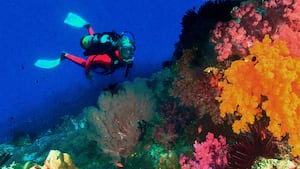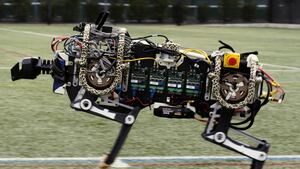In 2012, acclaimed oceanographer Paul Snelgrove told a TEDTalk audience that the next frontier wasn’t in our skies, but rather underwater.
“We know more about the surface of the Moon and about Mars than we do about the deep sea floor despite the fact that we have yet to extract a gram of food, a breath of oxygen, or a drop of water from those bodies,” he said.
Seven years later, over 80 percent of the ocean remains unmapped. Sonar can map less than 10 percent of the ocean’s bottom and satellite gravity data cannot detect anything smaller than a kilometer in size.
But a global competition sponsored by Shell, the Ocean Discovery XPRIZE, might change our understanding of Earth’s final frontier. The competition will dole out $7 million on Friday to the team producing the best technology for rapid, unmanned, and bathymetric—the measurement of the depth of water—exploration.
If making a device to explore the deep waterworld sounds easy, the finalists show that it’s not. Judging took place at the end of 2018 in Kalamata, Greece, after years of engineering and development, narrowing down the competition to five finalist teams. The goal: mapping a 500 kilometer square area of seafloor 4 km below the surface in under 24 hours with no human intervention and equipment fitting within a 40-foot container.
It turns out the best way to explore the deep sea are autonomous underwater vehicles, or AUVs—underwater-swimming robots that are computer-controlled. They work in tandem with autonomous surface vehicles, or ASVs, vessels that tow, deploy, and retrieve AUVs without humans.
AUVs come with a score of benefits for ocean exploration, diving deeper than human divers and floating on shallower waters for longer than boats. They can be easily manipulated by scientists, who can choose the kind of sensors they will attach to them according to their objectives. And they can carry sophisticated imaging-instrument than can detect hazards such as live underwater mines.
In fact, they can become powerful alliances to a wide range of human endeavors, from archaeological expeditions to hunt for shipwrecks to oceanographic endeavors to study water conductivity, pollutants, salinity, temperature, and more.
One strong example of such an AUV was that of Japan’s Team KUROSHIO, whose ASV actually towed multiple AUVs “by using a simple, customizable floating frame,” Takeshi Ohki, the team’s co-director, told The Daily Beast.
The grand feature of the Japanese design includes remote release mechanisms that can control poles holding a floating frame, allowing for ground-based mission control from satellites. That means scientists can map the seafloor efficiently to locate features.
A team composed of 15 members from around the world, GEBCO-NF Alumni Team, is competing with a multibeam echosounder on their design, which provides room for a sonar to chart the seabed.
“Our ASV does not only behave to the AUV… but can simultaneously do surveys at slightly lower resolutions and collect seafloor bathymetry data,” Rochelle Wigley, team lead, said.
These innovations aren’t cheap. The British team’s technology lead, Hua Khee Chan, told The Daily Beast that designs for AUVs can cost “at least $6 million.”
“An equivalent system from us will not go over $1.5 million,” Chan added.
Those costs add up with extraneous features that teams hope will add to our understanding of the ocean floor. Chan’s team is utilizing the “swarm approach,” a swarm of torpedo-like drones that swim vertically instead of horizontally.
“The conceptual idea was to create an ‘elevator’ that can access the ocean,” Chan explained. “Our drone swims vertically to the bottom of the ocean, ‘sees’ the seabed (this happens with the aid of an altimeter fitted in it), hovers at 100 m above it, and does a vertical 360-degree spin. At the same time, an embedded sonar records the line scan every 0.5 degrees and implanted sensors record parameters like temperature and salinity.”
And because the team made each drone ultra small and light, the same process can be simultaneously repeated by about 12 drones working simultaneously.
“Imagine what happens when all these drones work together; they will scan an area much greater than that a conventional AUV does and at a cost orders of magnitudes lower,” said Dale Wakeham, Chan’s partner and team lead.
One of the greatest challenges navigation in underwater environments faces is getting precise positioning because of the absence of GPS signal underwater. Team Arggonauts, Germany’s representation in the contest, equipped their AUVs with an extra sonar system to tackle this.
Arggonauts made their own swarm of 12 super light AUVs using syntactic foam and named them “Great Divers.”
Ulrich Pontes, head of communications at Fraunhofer IOSB, the research organization behind the team, said Great Divers were penetrable by water, but buoyant enough to swim.
To map the seabed, the Great Divers came equipped with bathymetric sonar systems; this was the point when a second sonar system came in handy. “It connected our Great Divers with our surface vehicles and synced atomic clocks for precise time measurements,” Pontes said.
Having this information, the Arggonauts then calculated the position of the Great Divers relative to that of the GPS-enabled surface vehicles to generate their map.
No matter which team wins, the endeavors are likely to change—perhaps even transform—our understanding of the world’s oceans in the next few years.
XPRIZE Ocean Discovery lead Jyotika Virmani said that each team has contributed to humanity’s understanding of the ocean floor in a way we never knew possible before. “These are prototype technologies,” she said. “Next, we will get them out there in the field. Our goal is to have a complete map of the world’s oceans by 2030.”







